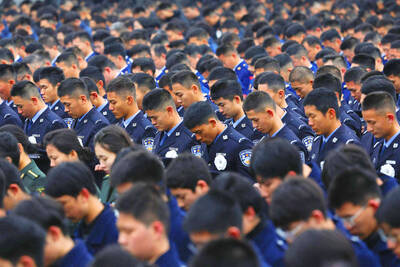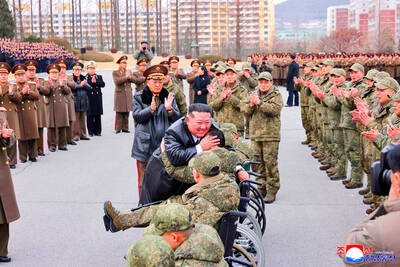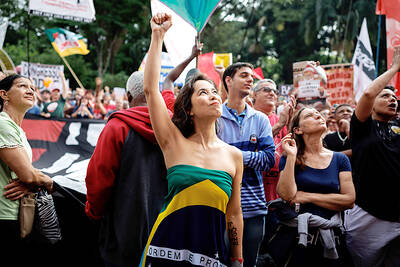It was meant to be an unabashed celebration of the triumph of communism in China, and of Chinese President Xi Jinping’s (習近平) authority as the country’s undisputed leader for years to come, but as the People’s Republic of China (PRC) approaches its 70th anniversary on Oct. 1, Xi finds himself battling threats on multiple fronts.
From a biting US trade dispute to relentless protests in Hong Kong challenging his rule and international condemnation over Beijing’s treatment of Uighur minorities in Xinjiang, Xi is having a very bad year, analysts say.
Furthermore, the crises have left him with limited room to act and simultaneously shore up support at home.
“Xi Jinping has had the toughest year since he came to power,” said Eleanor Olcott, China policy analyst at research firm TS Lombard.
“Not only is he facing unrest on China’s peripheries in Hong Kong and Xinjiang but the trade war is weighing on an already slowing domestic economy,” Olcott said.
Few expected things to turn out this way.
In Davos in 2017, just weeks after protectionist Donald Trump was inaugurated US president, Xi was at pains to portray himself as a champion of globalization, outlining a role for China as a world leader.
Some even hoped he would open the door to further reform, but those expectations have now sunk.
“The Xi Jinping of Davos 2017, who emerged on the world stage as defender of the liberal global economic order, is unrecognizable today,” Olcott said.
By the time he secured his second term as the Chinese Communist Party’s (CCP) general secretary in October 2017, Xi was at the center of a cult of personality built by the state.
Last year, he enshrined “Xi Jinping Thought” in China’s constitution and, in a shock move, removed term limits on individuals — overturning an orderly system of succession put in place to prevent the return of another all-powerful strongman such as Mao Zedong (毛澤東).
Xi has used crackdowns on corruption and calls for a revitalized party to become the most powerful Chinese leader in decades, and the constitutional changes mean he can rule for as long as he wishes, but stamping his personal brand on the government means Xi’s leadership is directly intertwined with the current headwinds.
An unexpected and festering trade dispute with the US has eroded confidence and hit the economy hard.
Furthermore, his signature Belt and Road Initiative has faced setbacks, with critics saying the plan is designed to boost Beijing’s influence, lacks transparency and is likely to saddle partner governments with debt.
The crackdown on Uighurs in Xinjiang — a region deemed crucial to the initiative’s success — has come under heavy international condemnation for reportedly placing an estimated 1 million mostly Muslim ethnic minorities in internment camps in the name of counterterrorism.
“Xi largely created the problems that are now major challenges for him and for China,” said Steve Tsang (曾銳生), director of the School of Oriental and African Studies’ China Institute at the University of London. “They are all products of Xi’s policies.”
Yet the biggest challenge to Xi’s authority has come from the semi-autonomous hub of Hong Kong and it appears to have caught him off-guard.
Dramatic images of mostly young pro-democracy protesters in Hong Kong facing riot police amid clouds of tear gas have dominated global newspapers and Web sites for weeks, as a movement calling for universal suffrage gathers pace.
Hong Kong, which was handed back by Britain to China in 1997, is ruled under a “one country, two systems” policy that gives citizens liberties unseen on mainland China.
Protesters say those rights have been steadily eroded and have openly criticized an increasingly assertive Beijing — provoking fears China could resort to a heavy-handed intervention to quash the unrest, unleashing disastrous consequences.
However, despite the hurdles facing him, the embattled leader’s hold on China remains firm — for now.
“None of the challenges has ‘blown up’ sufficiently for anyone within the top leadership to openly challenge him. As long as they stay in the shadow, Xi remains in charge,” Tsang said.
While international criticism mounts, analysts say that Xi and the CCP can potentially exploit the attacks on him to serve Beijing’s broader ideological needs.
“The CCP media machine has successfully framed the trade war and Hong Kong protests as a result of unfair foreign intervention that seeks to perturb China’s rise,” Olcott said.
“Xi will play up this narrative at the 70th anniversary celebrations, and stress that China must forge its own development path according to the chairman’s guiding ideology.”

China yesterday held a low-key memorial ceremony for the 1937 Nanjing Massacre, with Chinese President Xi Jinping (習近平) not attending, despite a diplomatic crisis between Beijing and Tokyo over Taiwan. Beijing has raged at Tokyo since Japanese Prime Minister Sanae Takaichi last month said that a hypothetical Chinese attack on Taiwan could trigger a military response from Japan. China and Japan have long sparred over their painful history. China consistently reminds its people of the 1937 Nanjing Massacre, in which it says Japanese troops killed 300,000 people in what was then its capital. A post-World War II Allied tribunal put the death toll

FALLEN: The nine soldiers who were killed while carrying out combat and engineering tasks in Russia were given the title of Hero of the Democratic People’s Republic of Korea North Korean leader Kim Jong-un attended a welcoming ceremony for an army engineering unit that had returned home after carrying out duties in Russia, North Korean state media KCNA reported on Saturday. In a speech carried by KCNA, Kim praised officers and soldiers of the 528th Regiment of Engineers of the Korean People’s Army (KPA) for “heroic” conduct and “mass heroism” in fulfilling orders issued by the ruling Workers’ Party of Korea during a 120-day overseas deployment. Video footage released by North Korea showed uniformed soldiers disembarking from an aircraft, Kim hugging a soldier seated in a wheelchair, and soldiers and officials

‘NO AMNESTY’: Tens of thousands of people joined the rally against a bill that would slash the former president’s prison term; President Lula has said he would veto the bill Tens of thousands of Brazilians on Sunday demonstrated against a bill that advanced in Congress this week that would reduce the time former president Jair Bolsonaro spends behind bars following his sentence of more than 27 years for attempting a coup. Protests took place in the capital, Brasilia, and in other major cities across the nation, including Sao Paulo, Florianopolis, Salvador and Recife. On Copacabana’s boardwalk in Rio de Janeiro, crowds composed of left-wing voters chanted “No amnesty” and “Out with Hugo Motta,” a reference to the speaker of the lower house, which approved the bill on Wednesday last week. It is

Cozy knits, sparkly bobbles and Santa hats were all the canine rage on Sunday, as hundreds of sausage dogs and their owners converged on central London for an annual parade and get-together. The dachshunds’ gathering in London’s Hyde Park came after a previous “Sausage Walk” planned for Halloween had to be postponed, because it had become so popular organizers needed to apply for an events licence. “It was going to be too much fun so they canceled it,” laughed Nicky Bailey, the owner of three sausage dogs: Una and her two 19-week-old puppies Ember and Finnegan, wearing matching red coats and silver